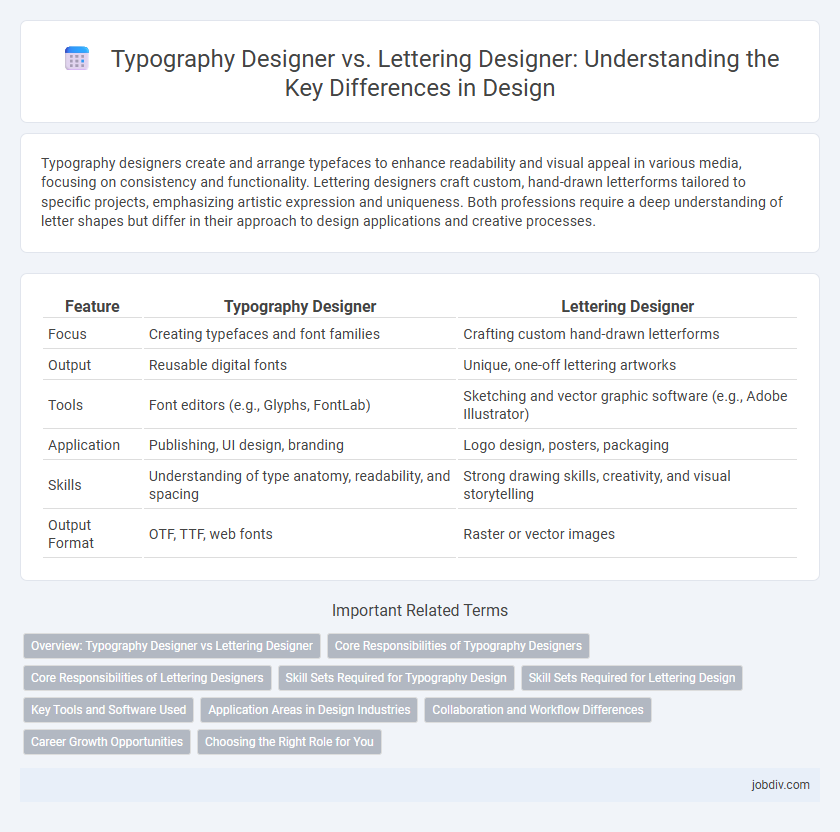Typography designers create and arrange typefaces to enhance readability and visual appeal in various media, focusing on consistency and functionality. Lettering designers craft custom, hand-drawn letterforms tailored to specific projects, emphasizing artistic expression and uniqueness. Both professions require a deep understanding of letter shapes but differ in their approach to design applications and creative processes.
Table of Comparison
| Feature | Typography Designer | Lettering Designer |
|---|---|---|
| Focus | Creating typefaces and font families | Crafting custom hand-drawn letterforms |
| Output | Reusable digital fonts | Unique, one-off lettering artworks |
| Tools | Font editors (e.g., Glyphs, FontLab) | Sketching and vector graphic software (e.g., Adobe Illustrator) |
| Application | Publishing, UI design, branding | Logo design, posters, packaging |
| Skills | Understanding of type anatomy, readability, and spacing | Strong drawing skills, creativity, and visual storytelling |
| Output Format | OTF, TTF, web fonts | Raster or vector images |
Overview: Typography Designer vs Lettering Designer
Typography designers specialize in creating and arranging typefaces that ensure readability and visual hierarchy across digital and print media. Lettering designers focus on crafting custom, hand-drawn letterforms tailored to specific projects, emphasizing artistic expression and uniqueness. Both roles require a deep understanding of letter structure, but typography designers prioritize functional type systems while lettering designers prioritize personalized, illustrative styles.
Core Responsibilities of Typography Designers
Typography designers specialize in creating and arranging typefaces to ensure legibility, readability, and aesthetic appeal across various media, focusing on typeface design, spacing, kerning, and grid systems. They develop custom fonts or modify existing ones to maintain brand consistency and optimize user experience in digital and print formats. Their core responsibilities include researching typographic trends, collaborating with UX/UI designers, and producing scalable type solutions tailored to specific communication needs.
Core Responsibilities of Lettering Designers
Lettering designers specialize in creating custom hand-drawn letters tailored specifically for logos, branding, and unique visual identities, emphasizing artistic expression and originality. Their core responsibilities include developing bespoke letterforms that convey specific brand messages, ensuring each character harmonizes with the overall design aesthetic. Unlike typography designers who work primarily with typefaces and standardized fonts, lettering designers focus on crafting one-of-a-kind letter illustrations that enhance visual storytelling.
Skill Sets Required for Typography Design
Typography designers must master font anatomy, kerning, leading, and grid systems to create visually balanced text layouts that enhance readability and brand identity. Proficiency in digital tools like Adobe Illustrator and font creation software such as Glyphs or FontLab is essential for developing custom typefaces and refining existing fonts. Understanding linguistic nuances, cultural context, and typographic history further enables designers to produce versatile and meaningful type solutions.
Skill Sets Required for Lettering Design
Mastering lettering design demands advanced proficiency in hand-drawing techniques, custom letterform creation, and intricate understanding of stroke weight and letter spacing. Lettering designers must excel in conceptualizing unique type treatments tailored to specific brand identities, requiring strong skills in sketching, vectorization, and manipulation of letters as visual elements. Expertise in software tools like Adobe Illustrator combined with a deep knowledge of historical and cultural typography influences enhances the ability to produce original, impactful lettering art.
Key Tools and Software Used
Typography designers primarily use software like Adobe Illustrator, Glyphs, and FontLab to create and modify typefaces, focusing on scalable vector designs and font development. Lettering designers rely heavily on tools such as Procreate, Adobe Photoshop, and traditional hand-drawing supplies to craft custom, hand-drawn letterforms with unique artistic styles. Both disciplines require a deep understanding of letter structure, but typography emphasizes digital font creation, whereas lettering prioritizes illustrative and bespoke design techniques.
Application Areas in Design Industries
Typography designers excel in creating typefaces for digital interfaces, print media, and branding, optimizing readability and visual hierarchy across websites, apps, and advertising. Lettering designers specialize in custom hand-drawn letterforms for logos, packaging, and editorial illustrations, enhancing brand identity with unique, artistic flair. Both play crucial roles in graphic design, but typography prioritizes consistent digital usability while lettering emphasizes bespoke visual expression.
Collaboration and Workflow Differences
Typography designers create scalable typefaces with consistent character sets optimized for digital and print use, relying on software like FontLab or Glyphs for efficient workflow. Lettering designers craft custom, hand-drawn lettering tailored to specific projects, emphasizing artistic expression and unique character forms through sketching and vector tools such as Adobe Illustrator. Collaboration differs as typography designers focus on technical precision and font family cohesion, while lettering designers work closely with creative directors and illustrators to integrate one-of-a-kind lettering into broader visual storytelling.
Career Growth Opportunities
Typography designers focus on creating and arranging typefaces for digital and print media, offering career growth in branding, editorial design, and user interface development. Lettering designers specialize in custom hand-drawn or digitally crafted letterforms, often progressing into areas like logo design, advertising, and fine art commissions. Both careers provide opportunities to expand into creative direction, teaching, and consulting within the design industry.
Choosing the Right Role for You
Typography designers specialize in creating typefaces that ensure readability and visual harmony across digital and print media, focusing on font creation and layout consistency. Lettering designers craft custom hand-drawn letters, emphasizing artistic expression and unique brand identity through bespoke letterforms. Choosing the right role depends on your preference for systematic type development versus personalized, illustrative lettering art.
Typography Designer vs Lettering Designer Infographic

 jobdiv.com
jobdiv.com